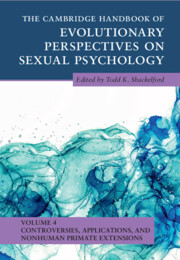Book contents
- The Cambridge Handbook of Evolutionary Perspectives on Sexual Psychology
- The Cambridge Handbook of Evolutionary Perspectives on Sexual Psychology
- Copyright page
- Contents
- Contributors
- Preface
- Part I Controversies and Unresolved Issues
- 1 The Female Sexual Orientation Spectrum in Evolutionary Perspective
- 2 The Evolution of Female Same-Sex Attraction
- 3 Male Bisexuality
- 4 Female Bisexuality
- 5 Masturbation in Primates
- Part II Applications to Health, Law, and Pornography
- Part III Nonhuman Primate Sexual Behavior
- Index
- References
4 - Female Bisexuality
from Part I - Controversies and Unresolved Issues
Published online by Cambridge University Press: 30 June 2022
- The Cambridge Handbook of Evolutionary Perspectives on Sexual Psychology
- The Cambridge Handbook of Evolutionary Perspectives on Sexual Psychology
- Copyright page
- Contents
- Contributors
- Preface
- Part I Controversies and Unresolved Issues
- 1 The Female Sexual Orientation Spectrum in Evolutionary Perspective
- 2 The Evolution of Female Same-Sex Attraction
- 3 Male Bisexuality
- 4 Female Bisexuality
- 5 Masturbation in Primates
- Part II Applications to Health, Law, and Pornography
- Part III Nonhuman Primate Sexual Behavior
- Index
- References
Summary
Bisexual behavior is an order of magnitude more common than exclusive homosexuality in women. Many evolutionary hypotheses on sexual orientation have focused on homosexuality, particularly in men, yet there has recently been a growing recognition that male and female homosexuality may have different evolutionary origins, and that the various forms of nonheterosexuality in the female sexual orientation spectrum may arise via discrete evolutionary–developmental mechanisms. Evolutionarily informed sex research therefore has the fascinating task of understanding the whole spectrum of female sexual orientation – from heterosexual, mostly heterosexual, and bisexual women through to exclusively homosexual women, and from feminine femmes to masculine butches – including the proximate mechanisms and ultimate functions that underlie that variation. Here, we address that task by applying Tinbergen’s four questions to analyze female bisexuality, synthesizing existing research on proximate mechanisms, ontogeny, phylogeny, and ultimate functions. Research in psychology and behavioral sciences indicates that bisexual women comprise a group distinct from heterosexual women and, on some metrics, even from lesbian women: bisexual women have more male-typical personality traits, more unrestricted sociosexual attitudes and behaviors, higher sexual responsiveness, earlier reproduction, higher substance use, higher incarceration rates, and worse health outcomes than heterosexual women. There is broad evidence from across mammalian species that indicates that individual differences in prenatal exposure to sex hormones creates individual differences in brain morphology, cognition, behavioral predispositions, and even life outcomes. They are typically studied in a sex differences framework, but there is now enough evidence to suggest that sexual orientation differences along these parameters can also be robust and informative. We review ten ultimate-level hypotheses on the evolution of female bisexuality and conclude that four hypotheses – balanced polymorphism of masculinity, sexually antagonistic selection, hormonally mediated fast life history strategy, and by-product – are currently best supported by evidence. These hypotheses are also consilient with the wealth of neurodevelopmental evidence on the masculinization of the brain and behavior, which is thought to underlie variation in female sexual orientation. By synthesizing ultimate functions with proximate mechanisms – combined with powerful mid-level frameworks such as life history theory – evolutionary scientists are in a stronger position to provide a comprehensive account of the phenotypic variation observed in the female sexual orientation spectrum.
Keywords
- Type
- Chapter
- Information
- Publisher: Cambridge University PressPrint publication year: 2022
References
- 3
- Cited by



